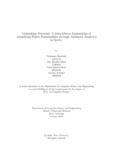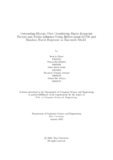Unleashing potential: a data-driven exploration of identifying player potentialities through advanced analytics in sports
Abstract
In this project, we delve deeper into the complex area of predicting a potential replacement
of a footballer of a specific position. For that, we used multiple machine
learning models on the Sofifa dataset. Our analysis reveals interesting insights into
the predictive capabilities of these models, with a particular focus on numerical performance
measures. Among the models tested, the LightGBM Regressor appears
to be the epitome of predictive power. This algorithm consistently outperforms the
others, showing the lowest mean squared error (MSE) and highest R-squared value
on both the test data set and the overall data set. Her ability to navigate the complexity
of player performance patterns is evident, making her a leader in our prediction
arsenal. Complements for Random Forest Regressor, XGBRegressor Regressor,
LightGBM Regressor, and CatBoost Regressor demonstrate superior performance,
characterized by consistently low MSE values and high R-squared values. These
gradient boosting algorithms demonstrate their effectiveness in capturing complex
patterns in the Sofia dataset. The Linear Regressor model utilizes its power in understanding
the linear releationships among the data and gives a higher accuracy
too. The KNeighbors-Regressor, with its proximity-based approach, also achieves
stripes, especially by achieving high R-squared values. This model excels at identifying
players with similar characteristics, highlighting their collective impact on
overall performance. It should be noted that, Support Vector Regressor (SVR) and
Neural Network models provide valuable insights, despite relatively lower prediction
accuracy. These models highlight the complexity inherent in player forecasting and
highlight the need for meticulous parameter tuning. LightBGM Regressor stands
out as the superior model for predicting our research, closely followed by XGBRegressor,
Random Forest Regressor, CatBoost Regressor. These results highlight the
importance of selecting models that match the variation of the data set to accurately
and reliably predict performance in soccer analytics.
Keywords
Machine learning; Sofifa dataset; Random forest regressor; Linear regressor; KNeighbors regressor; Neural network; Sports analytics; CatBoost regressor; LightGBM regressorDescription
This thesis is submitted in partial fulfillment of the requirements for the degree of Bachelor of Science in Computer Science, 2024.Department
Department of Computer Science and Engineering, Brac UniversityType
ThesisCollections
Related items
Showing items related by title, author, creator and subject.
-
Early detection of chronic kidney disease using machine learning
Abrar, Tahmid; Tasnim, Samiha; Hossain, Md. Mehrab (Brac University, 2019-09)Chronic kidney disease (CKD) is a global prevalent ailment that causes lives in a predominant number. CKD is the 11th most deadly cause of global mortality with 1.2 million death each year and according to kidney Foundation ... -
Sales forecasting using machine learning
Nabil, Sadman Sakib; Islam, Md Tanvir; Muhit, Sadman Aziz (BRAC University, 2024-10)In today’s aggressive and fast-paced economy, the ability to forecast sales accurately and effectively denotes a proper utilization of the available resources in planning. Typical sales forecasting methods fail quite ... -
Forecasting bitcoin price considering macro economic factors and media influence using bidirectional LSTM and random forest regressor as ensemble model
Ghose, Swattic; Bin Khaled, Faiyaz; Rafin, Nafiz Imtiaz; Jawwad, Rubaiyet Hossain; Bin Yahiya, Yamin (Brac University, 2023-01)The decentralized cryptocurrency has created many opportunities for secure and safe financial transactions with a bright prospect. The cryptocurrency market rapidly expands, leading to erratic price movements due to ...




